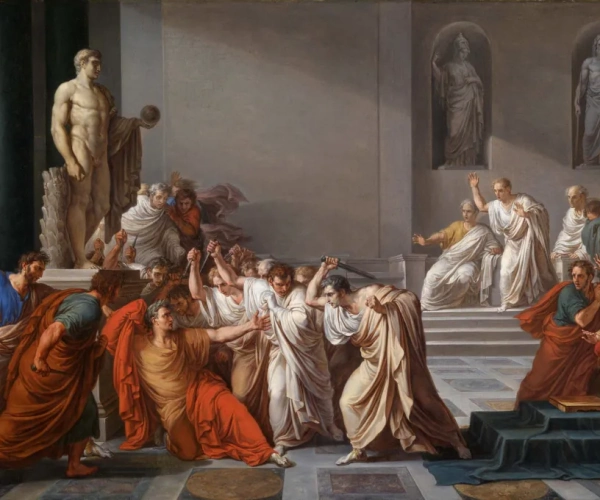Death of Julius Caesar (100-44 BC)
Vincenzo Camuccini, an eminent figure in the Neoclassical movement, etched his name in the annals of art history with his masterpiece, "The Death of Julius Caesar." This painting, created in the early 19th century, delves into a pivotal moment in ancient history—the assassination of Julius Caesar in 44 BC. Camuccini's work stands as a testament to his meticulous study of classical antiquity, reflecting a profound understanding of its aesthetics and values.
The painting is a masterful orchestration of composition and emotion, encapsulating the drama of Caesar's final moments. Camuccini's canvas is not merely a historical recount but a study in human emotion and political intrigue. Each character in the scene is rendered with precise detail, their expressions and postures contributing to the narrative's tension. The central figure, Julius Caesar, is depicted at the moment of his betrayal, surrounded by the conspirators, including Brutus. The expression on Caesar's face, a blend of shock and resignation, captures the tragedy of betrayal by a trusted friend.
Camuccini's use of light and shadow plays a crucial role in the painting, highlighting key figures and moments, thereby guiding the viewer's eye through the unfolding drama. The architectural elements in the background, inspired by classical Roman structures, add authenticity to the scene, anchoring it firmly in its historical context. The artist's attention to detail in the depiction of Roman attire and the interior of the Senate adds layers of realism to the work.
What sets Camuccini's depiction apart is not just its historical accuracy, but its emotional resonance. The painting transcends its function as a historical document; it becomes a timeless exploration of themes such as power, betrayal, and the fragility of human life. It invites viewers to contemplate the complexities of political power and the human condition, making it relevant across ages.
In conclusion, Vincenzo Camuccini's "The Death of Julius Caesar" is more than just a visual representation of a historical event. It is a profound statement on the human experience, encapsulated in a moment of time but echoing through the ages. Through this masterpiece, Camuccini not only honors the classical traditions but also contributes significantly to the narrative of art history.







No Comments Yet...